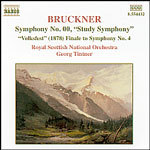
Bruckner: Symphony No. 00 / Finale to Symphony No. 4
 $25.00
Out of Stock
$25.00
Out of Stock6+ weeks add to cart
ANTON BRUCKNER
Bruckner: Symphony No. 00 / Finale to Symphony No. 4
Royal Scottish National Orchestra / Georg Tintner, conductor
[ Naxos / CD ]
Release Date: Saturday 8 January 2005
This item is currently out of stock. It may take 6 or more weeks to obtain from when you place your order as this is a specialist product.
"The pattern of the later symphonies is set here, emotional slow movement, galumphing scherzo and all. But there are moments of almost Sullivanesque sparkle. Tintner's account is wonderfully cohesive and fresh."
- The Sunday Times (Paul Driver), May 21, 2000
"Here is another, indeed the next-to-last, release in the complete Bruckner Symphony edition conducted by the late Georg Tintner. Again avoiding the extremes of imperial grandeur or deeply religious weightiness, Tintner here brought his talent for fluent, coherent, beautifully balanced playing to music for which it is especially appropriate."
- Fanfare (Robert McColley), July-August, 2000
"The pattern of the later symphonies is set here, emotional slow movement, galumphing scherzo and all. But there are moments of almost Sullivanesque sparkle. Tintner's account is wonderfully cohesive and fresh."
- The Sunday Times (Paul Driver), May 21, 2000
"The late Georg Tintner's splendid Bruckner cycle is nothing if not comprehensive. Here is the Study Symphony in F minor, composed in 1863, which Bruckner later disowned but did not destroy. He was right not to for it is delightful, influenced by Schumann and Mendelssohn. The scherzo is the movement that takes us nearly to the mature Bruckner. Also on the disc is one of the three versions of the finale of the Symphony No. 4 (Romantic). This is the second (1878), know as Volksfest. We usually hear the last (1880) version which differs quite markedly. It is all part of the full discovery of Bruckner to which Tintner made such an important contribution."
- The Sunday Telegraph (Michael Kennedy), 14 May 2000
Bruckner's last composition teacher, the young opera conductor Otto Kitzler, set him three final tasks with which to finish his studies: one overture, one choral work and a symphony. Our composer completed his 'Study Symphony', also known as No. 00, in three months. The reaction of Kitzler to this charming work was not very flattering: 'Not particularly inspired'. I can only wonder whether he had a good look at the Scherzo. To me this Scherzo (though perhaps not so much its Trio) is a piece of great originality, probably even better than some other early Scherzos of Bruckner. It is true that Bruckner learned a lot about Wagner's harmonic and orchestral achievements, but I am not so sure that he profited a great deal from Kitzler's instruction. The Study Symphony, however, does not show much influence of Wagner, but the score is full of Schumann and Mendelssohn - notably the beginning of the Finale, which really sounds as if it had been composed by Schumann.
Bruckner disowned the Study Symphony, but he did not destroy the score, as was his habit with works he totally rejected. This fact permits us, I think, to perform it. Apart from its charm it makes us marvel that only one year later he created his first masterpiece, the wonderful Mass in D minor.
The symphony starts with a gentle dance-like tune in the first violins. This is answered by a loud tutti (though I took the liberty of modifying the dynamics in the brass to avoid its coarse effect). Those two motifs are splendidly developed. The second main melody, in the major, is lyrical. A rather heroic statement follows, and a gentle flute melody ends the exposition. An expert development leads to the slightly shortened recapitulation (I must confess that I miss the lovely flute tune, excised here).
The Andante molto begins with a pleading tune in the strings. A dotted rhythm leads to a gentle melody in the oboe. The first violins and violas alternate with demisemiquaver (32nd-note) runs, obviously influenced by a similar place in the second movement of Mozart's Symphony No. 41, the' Jupiter'. A rather conventional episode in G minor leads to the recapitulation. Here the 'Jupiter' 32nd-notes are distributed between flute, clarinet and bassoon. The movement ends with a gentle duet between horn and timpani.
The splendid Scherzo starts with a rhythmical theme in clarinets and bassoons alternating with even staccato notes in the strings. Both the music and the orchestration are particularly inspired! Woodwind and strings with pleasant quaver (eighth-note) runs in violas and cellos start the gentle Trio, followed by horns and first violins.
The Finale is probably the weakest movement of the four, but has some beautiful episodes, especially the gently syncopated second melody. Triplets dominate the end of the exposition. A gentle horn starts the development with the Schumann motif. It travels through other keys and after the recapitulation it gradually turns to F major; the tempo increases and this fine symphony ends in jubilation.
- 1999 Georg Tintner
